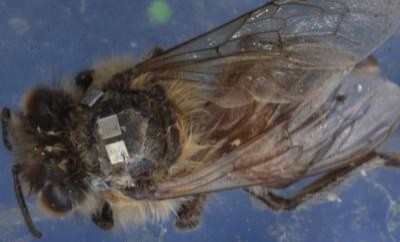'Zombee' Apocalypse: Researchers Ask Citizens To Be On Lookout For Parasite-Infected Bees

This is not a horror movie, though it could be: in San Francisco, scientists are gluing radio trackers to honey bees and asking citizens to be on the lookout for a plague of zombie insects.
The zombifying agent is the fly Apocephalus borealis, which lays eggs on a honey bee's abdomen. Infected bees behave very differently from normal ones, leaving their hives at night and swarming around lights, like moths. Eventually they become stranded outside and die.
San Francisco State University biologists are tagging bees infected with the parasite with little radio trackers to monitor their on-campus movements and flight behavior. Laser readers installed in an experimental hive scan the bees to track their comings and goings, which could help scientists understand how A. borealis triggers infected bees' nighttime wanderings.
"We are also interested in knowing if parasitized foragers are the recipients of aggression by other workers, for example if they're expelled from the hive, or if parasitized foragers behave in ways that disrupt hive productivity," SFSU biologist Andrew Zink said in a statement on Thursday.
The biologists have also set up a website called ZomBee Watch where people can report sightings of their own.
Concerned citizens that spot disoriented bees in their area can also make simple traps to collect 'zombees.' One of the designs offered by Zombee Watch uses a florescent bulb, a metal light fixture, duct tape, and a flowerpot. Once you collect a few bees, you watch them for signs of infection - little brown pills, the fly pupae, should emerge in a week, and from those, adult flies a few weeks later - and enter your observations on the ZomBee Watch website.
"Not all honey bees attracted to light produce Zombie Fly pupae. Whether or not you find parasitized bees, we are interested in your records," the researchers say.
There's a possibility that the fly's parasitism could be contributing to colony collapse disorder, a phenomenon where worker bees mysteriously abandon their hives, leading to the death of the entire colony. Colony-wide dieoffs have become more and more prevalent since the mid-2000s, and the loss of honeybees threatens many bee-pollinated crops.
Many theories have been floated to explain colony collapse disorder - mites, disease, stress, pesticides, even cell phone radiation. There may not even be a single cause. But the bizarre behavior of bees infected by A. borealis definitely makes that parasite a prime suspect.
SFSU biologist Andrew Core and his team first described how A. borealis was preying on bees in a paper that appeared in the journal PLoS ONE in January. In their study, researchers found infected bees in 77% of 31 sample sites across the San Francisco Bay Area.
Now, with both the radio trackers and the help of citizen scientists, researchers hope to get a clearer picture of how wide the zombee menace has spread across the country. In some hives in California, up to 18% of the foraging bees are infected.
"Hopefully in the long run, this information might help us understand how much of a health concern these flies are for the bees, and if they truly do impede their foraging behavior," SFSU researcher Christopher Quock said in a statement. "We also want to know whether there are any weak links in the chain of interactions between these flies and honey bees that we could exploit to control the spread of this parasite."
© Copyright IBTimes 2025. All rights reserved.





















